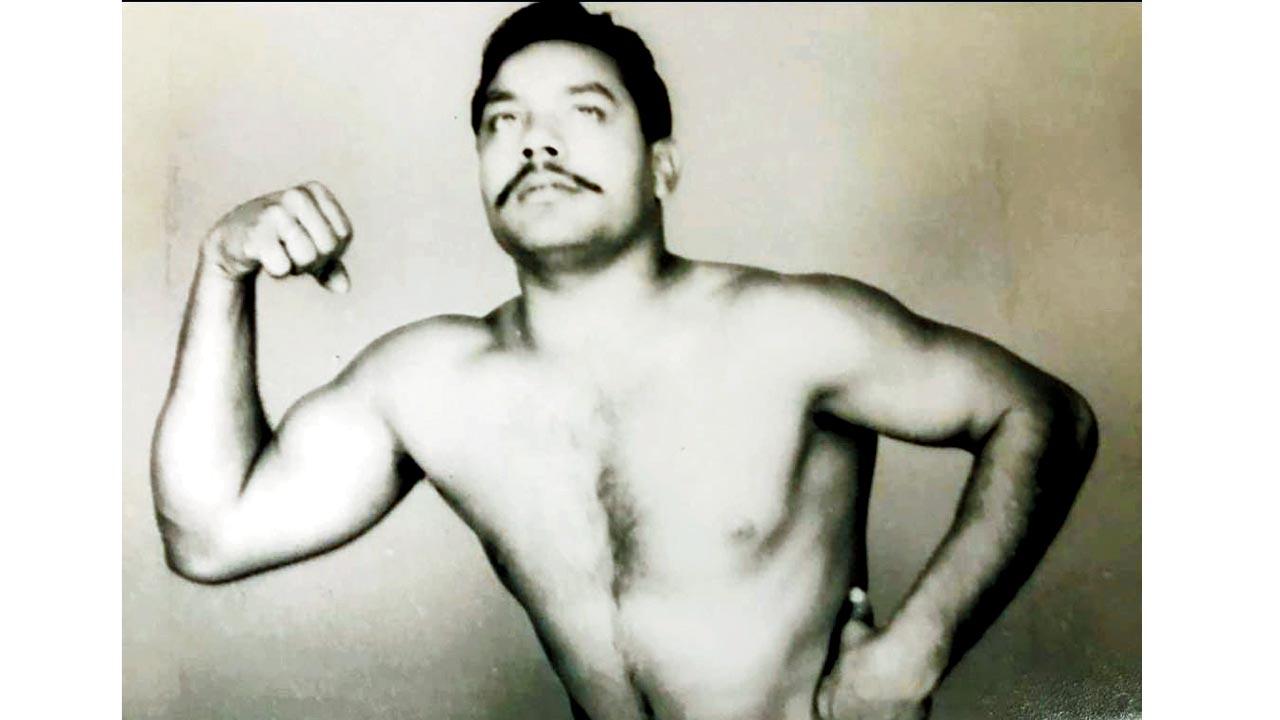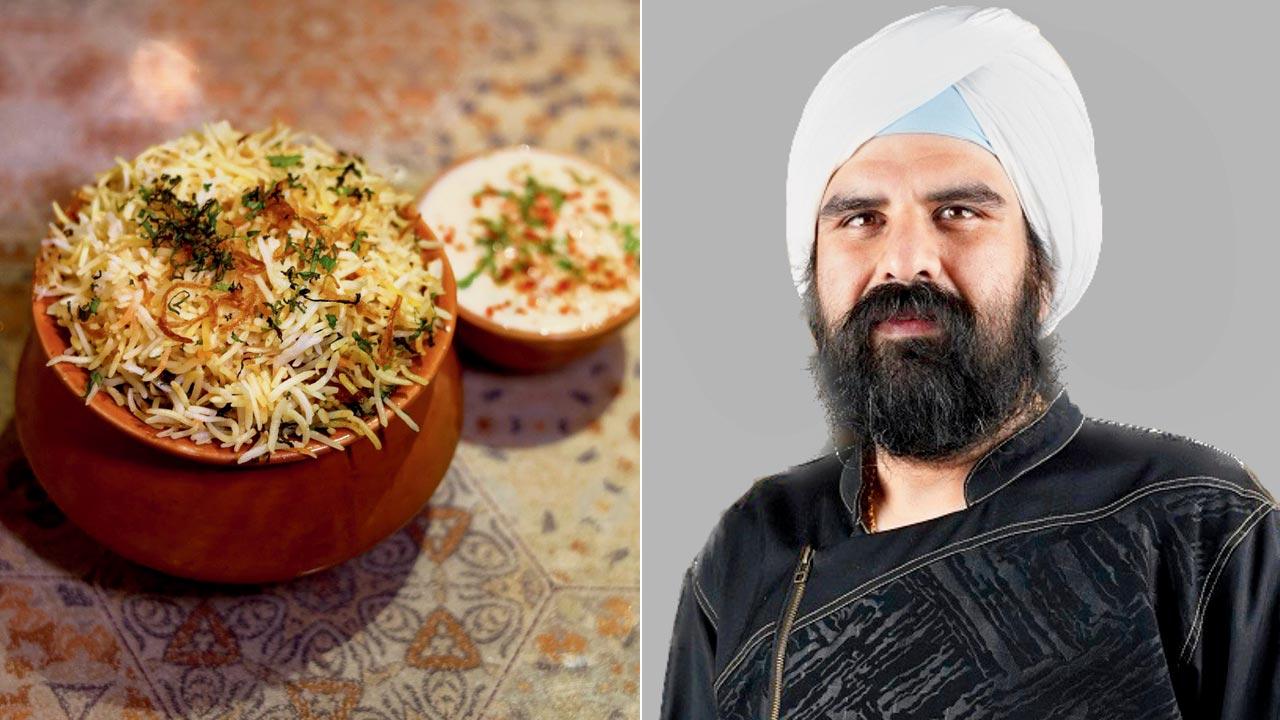Chef Imtiaz Qureshi carved a niche for Awadhi and Lakhnawi cuisine, giving it the nazakat of fine dining. City chef-restaurateurs and his family members recall why his culinary legacy will last the ages

Late chef Imtiaz Qureshi with his son, (right) Ishtiyaque; (Right) A dated photograph of Qureshi preparing a seekh kebab
On a busy day in the Dum Pukht kitchen at ITC Sonar, Kolkata, chef Mukhtar Qureshi was slouching over while preparing the galouti kebab. Suddenly, a heavy slap landed on his back. His ‘dur ke fufaji’, the late chef Imtiaz Qureshi, under whom Mukhtar was apprenticing in 2003, had dropped by.
ADVERTISEMENT
“He took me aside and said, ‘Khana banana hai to shaan se banao. Jhuk kar nahi. Dil se khilana hai toh ankh aur seena dono milne chaiye.’ His lecturing was also lengthy, just like his dum pukht cooking,” Mukhtar smiles.
 Qureshi as a wrestler
Qureshi as a wrestler
Earlier this month, on February 16, chef Imtiaz Qureshi, Padma Shri-awardee (2016), passed away at 93. He dedicated 40 years of his life to rediscovering, reinventing and refining Awadhi and Lakhnawi cuisine. Born into a family of butchers in Lucknow, at the young age of nine, Imtiaz was sent to apprentice under his relative ustad Haji Ishaq in Hussainganj. “My father had two passions — pehelwani aur pakana [wrestling and cooking]. He would tell me how he had to lift 100-kg flour bags, prep the tandoor, and even remove it off the ground at the end of the day. He would do all the mis en place in the hope to get to learn and make sheermal and rotis in the tandoor and kebabs in the grill.”
Later, he began working as a chef at Hotel Krishna in Hazratganj in Lucknow, and was much-loved for his catering. Following this, he joined Lucknow’s first five-star hotel, Clarks in 1973. “In 1976, the then ITC chairman, late Ajit Haksar had a vision to introduce Indian cuisine concepts in the hotels. He entrusted the task to retired employee Mr. Sabarwal to bring Imtiaz Qureshi on board ITC hotels. However, it was the armed forces personnel who frequented Mohammed Baug club in Lucknow who eventually convinced Imtiaz to move to Mughal Sheraton Agra where he opened Navratna. In a year, he moved to Delhi to launch ITC Maurya, where he was in charge of the Indian cuisine at the coffee shop, and restaurants Mayur, Dum Pukht and Bukhara,” recalls Ishtiyaque, Imtiaz’s eldest son who began working with his father since he was 13.
 Imtiaz Qureshi during a visit to Mumbai. File pics; (Right) Chefs Manjit Gill (left) with Qureshi at a food festival in Venezuela in the 1980s. Gill recalls they were only two people: “I was manning the tandoor outside, and he was handling the curries, biryani, and dal inside.”
Imtiaz Qureshi during a visit to Mumbai. File pics; (Right) Chefs Manjit Gill (left) with Qureshi at a food festival in Venezuela in the 1980s. Gill recalls they were only two people: “I was manning the tandoor outside, and he was handling the curries, biryani, and dal inside.”
Making of the legacy
Food historian Pushpesh Pant calls him the first celebrity chef of India. “No one respected Indian cuisine or heritage chefs until Imtiaz Qureshi. People were obsessed with attending catering college and Le Cordon Bleu, and making Continental food at five-stars — food that the white man ate. Here was a man who didn’t speak English, had never been to catering school but had great skills. He had a personality to match — a big man, grey hair, a crowbar moustache and loud laughter. He was confident as well as generous,” reminisces Pant.
Pant believes that the first step to creating a legacy was to restore the self-respect of the Indian diner as well as the cooks. “People had not experienced Awadhi cuisine as fine dine, as the offerings were limited to street-style chaat such as seekh and galouti kebabs. Imtiaz made kormas and kaliyans, and vegetables that were slow-cooked in traditional copper pots. He highlighted Lucknow’s vegetarian fare including tamatar ka shorba, parwar ka dolma, achari baigan, baigan ki lonje. His shahi tukda was to die for,” elaborates Pant.
In Delhi, where Punjabi eateries like Moti Mahal, Gulatis and Kake da Dhaba dominated, Imtiaz held his own. “He regarded himself to be the custodian of Lakhnawi recipes, and had the grace to admit he was not a royal cook. He made a good point that butchery goes hand in hand with great cookery: without a good butcher, no bawarchi can work his magic. He has to work with the right cut of meat, how long it will take to cook and how much salt it will require,” reveals Pant.
The second contribution was roping in relatives to join him in the kitchen and training chefs under him. This opened the window for Indian chefs to travel overseas and work in Indian restaurants instead of continental kitchens.” Pant is hopeful that his legacy will be kept alive by the likes of chefs such as Ranveer Brar, Kunal Kapur, Sadaf Hussain and Nishant Chaubey.
Dum pukht dossier
One of the chefs who worked closely with Qureshi was chef (Dr) Manjit Singh Gill. “I collaborated for 40 years until his retirement in 2016. I learnt a lot from his skills, and coordinated to create new concepts, themes, and bespoke caterings in banquets — he reported to me due to hierarchy, but I looked up to him as my master. Until he arrived on the scene, there was limited variety of Indian fare in five-stars beyond a few kebab variations, handful of curries, and dal makhani. He created the version of biryani that continues to be served across today’s restaurants. He had a unique approach to the cuisine,” shares Gill, president of the Indian Federation of Culinary Associations and former corporate chef at ITC Hotels. Gill and Qureshi combined their strengths. “While working on dum pukht, the challenge was to convert a bulk preparation for an à la carte restaurant so that guests could order in portions. Today, every restaurant is following this trend,” suggests Gill.
Chef Mukhtar, who created his own expressions of Awadhi and Lakhnawi cuisine at Neel at Tote on the Turf and Ummrao at JW Marriott Sahar, points out that diners were unaware of the royal food of the nawabs. “Unki soch alag thi. He set out to make cuisine that both kids and adults could savour. Awadhi khana zameen se juda hua hai; usme mehnat aur dimag donon ki zaroorat hai.”
About the famous dal bukhara, Ishtiyaque reveals that it was left on the tandoor bukhari (which is how it gets its name) overnight in a copper pot, “The cooking was inspired by the process used to make moong gosht, mas kaliya and khichda.” He leaves us with warm moments from the last years with the great chef: “Abba loved a well-made biryani, kakori kebab, salad and paya. Whenever he came home, it was a daawat.”
Chef Imtiaz Qureshi, the gamechanger
 Dum pukht biryani; (right) Ishijyot Surri
Dum pukht biryani; (right) Ishijyot Surri
At Mulk, our culinary tradition is based on Qureshi’s technique and inspired by some of his iconic recipes. Our dum pukht biryani is carefully arranged in layers with juicy meat or vegetables and finally cooked together under one sealed pot. We follow the slow cooking technique as it represents the authentic revival of time-honoured traditions that demonstrate the unmatched artistic finesse as well as the intricate nature of Indian food cultures.
Ishijyot Surri, executive chef, Mulk, Andheri
When my father opened Khyber in 1958, he served North West Frontier cuisine tweaked to suit Gujarati palates. It was slightly sweeter and low on spice. There was a classic way to prepare such fare until chef Qureshi arrived on the scene, and introduced slow cooking in a five-star kitchen,” recalls Bahl, confessing his restaurant doesn’t follow this style. “We have a happy problem; if we change our menu, our regulars will complain. Our classic dishes include paneer korma, nalli nihari and raan, which have remained consistent since its inception. Dum cooking is extremely tedious and time-consuming. It has
to be done at leisure, in a five-star kind of environment. In our environment, it’s a challenge to execute it,”
he signs off.
Sudheer Bahl, owner of Khyber, Fort
 Subscribe today by clicking the link and stay updated with the latest news!" Click here!
Subscribe today by clicking the link and stay updated with the latest news!" Click here!







